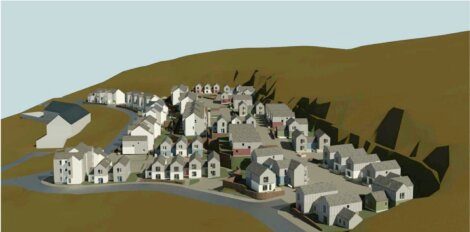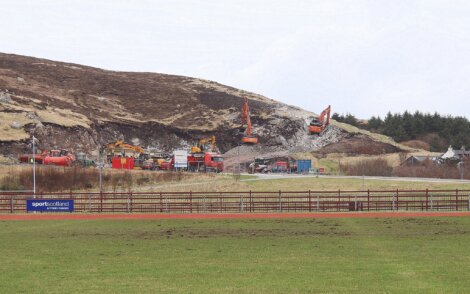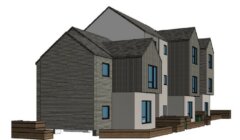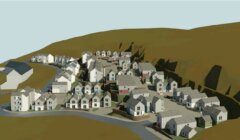Housing / Staney Hill work ‘on schedule’ as first housing contract set to go out to tender
PREPARATORY work on a new 300-home development in Lerwick is “on schedule and on plan” – with the contract for the first phase of housing set to go out to tender in March.
Hjaltland Housing Association chief executive Bryan Leask said it is hoped that the very first houses could be allocated in early 2028.
The large development will be carried out in phases over the space of around 15 years.
Boosted by £19 million of grant funding from the Scottish Government, initial infrastructure work – which includes a new spine road and services – continues to take place on the hill.
This has included plenty of rock breaking, which can be fairly audible in nearby areas.
But Leask confirmed that “continuous mass excavation of rock will be complete by the summer”.
He told a meeting of Lerwick Community Council on Monday that the first phase of housing work behind the Anderson High School hostel will include 66 units, and it is hoped that contractors could be on site for this towards the end of the summer.
This will be developed in phases of 32 units, 28 and then six.
This is to “encourage smaller scale contractors to get involved in developing houses for us”, Leask said.
“There’s an issue at the moment in Shetland generally about just the level of contractors and availability of contractors we have to do the larger scale contracts.”
Leask said at the moment E&H and DITT are “pretty much probably the only two capable of doing any kind of reasonable sized contract”.
“But we need to find a way to encourage some of the smaller scale contractors to actually come up and do it,” he added.
Become a member of Shetland News
Leask later told the meeting that he would like to see a retrospective review of a procurement policy which he feels is affecting smaller contractors, particularly in rural areas.
He noted how services contracts valued over £50,000 need to be advertised nationally.
Leask used the example of how Hjaltland was previously tendering a three-year project with a value of £180,000.
But it was classified as a service contract, and due to the value it had to be advertised nationally.
Leask said a “one man band” contractor had been doing that work for the association up to that point.
But due to the procurement requirements the contractor ultimately said he felt there was no point in applying.
“I would like to see a retrospective review of that policy in terms of procurement, because it came through before the islands impact assessment was a thing, and I would like that policy to be retrospectively assessed,” Leask said.
He described it as a “one size fits all approach”.
“Across all rural areas it is impacting on contractors’ ability to access that work,” Leask said.
He noted how the value of the upcoming six-unit Staney Hill contract would be less than £2 million, meaning that the works contract would not need to be advertised nationally through Public Contracts Scotland.
Meanwhile the housing chief added that Staney Hill will form the “core” piece of work for Hjaltland over the next 15 years.
He also told the meeting that because the development will access the Lerwick district heating system, it could open up the possibility for some other nearby residential areas lacking a connection – such as Burnside and Norgaet – to get onto the network too.
Leask also said it was the first time in many years that Hjaltland did not actively have any housing units currently under construction.
He explained that the Staney Hill infrastructure work is the only project on site at the moment.
But Leask said there is a balance needing to be struck between new development and a legislative requirement to bring existing properties up to a certain standard.
He said Hjaltland has been doing a lot of work in the South Mainland on bringing some older properties “back up to effective new build standard”.
Leask also spoke generally about the high cost of building at the moment, particularly in Shetland.
He added that it appeared the level of interest from people applying for contractors and architects has “fallen off a cliff edge in the last six months”.
Leask said more people are doing extensions or improving their property as opposed to building new.
This, in turn, means Hjaltland Housing Association is seeing less movement of people.
He said the association usually turn over ten per cent of its 900-property stock a year, but this year it has reduced to around six per cent.
Become a member of Shetland News
Shetland News is asking its readers to consider paying for membership to get additional perks:
- Removal of third-party ads;
- Bookmark posts to read later;
- Exclusive curated weekly newsletter;
- Hide membership messages;
- Comments open for discussion.
If you appreciate what we do and feel strongly about impartial local journalism, then please become a member of Shetland News by either making a single payment, or setting up a monthly, quarterly or yearly subscription.

















































































